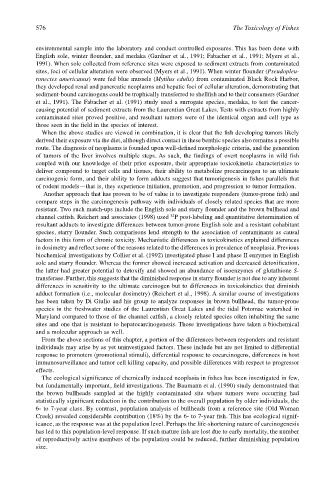Page 596 - The Toxicology of Fishes
P. 596
576 The Toxicology of Fishes
environmental sample into the laboratory and conduct controlled exposures. This has been done with
English sole, winter flounder, and medaka (Gardner et al., 1991; Fabacher et al., 1991; Myers et al.,
1991). When sole collected from reference sites were exposed to sediment extracts from contaminated
sites, foci of cellular alteration were observed (Myers et al., 1991). When winter flounder (Pseudopleu-
ronectes americanus) were fed blue mussels (Mytilus edulis) from contaminated Black Rock Harbor,
they developed renal and pancreatic neoplasms and hepatic foci of cellular alteration, demonstrating that
sediment-bound carcinogens could be trophically transferred to shellfish and to their consumers (Gardner
et al., 1991). The Fabacher et al. (1991) study used a surrogate species, medaka, to test the cancer-
causing potential of sediment extracts from the Laurentian Great Lakes. Tests with extracts from highly
contaminated sites proved positive, and resultant tumors were of the identical organ and cell type as
those seen in the field in the species of interest.
When the above studies are viewed in combination, it is clear that the fish developing tumors likely
derived their exposure via the diet, although direct contact in these benthic species also remains a possible
route. The diagnosis of neoplasms is founded upon well-defined morphologic criteria, and the generation
of tumors of the liver involves multiple steps. As such, the findings of overt neoplasms in wild fish
coupled with our knowledge of their prior exposure, their appropriate toxicokinetic characteristics to
deliver compound to target cells and tissues, their ability to metabolize procarcinogen to an ultimate
carcinogenic form, and their ability to form adducts suggest that tumorigenesis in fishes parallels that
of rodent models—that is, they experience initiation, promotion, and progression to tumor formation.
Another approach that has proven to be of value is to investigate responders (tumor-prone fish) and
compare steps in the carcinogenesis pathway with individuals of closely related species that are more
resistant. Two such match-ups include the English sole and starry flounder and the brown bullhead and
32
channel catfish. Reichert and associates (1998) used P post-labeling and quantitative determination of
resultant adducts to investigate differences between tumor-prone English sole and a resistant cohabitant
species, starry flounder. Such comparisons lend strength to the association of contaminants as causal
factors in this form of chronic toxicity. Mechanistic differences in toxicokinetics explained differences
in dosimetry and reflect some of the reasons related to the differences in prevalence of neoplasia. Previous
biochemical investigations by Collier et al. (1992) investigated phase I and phase II enzymes in English
sole and starry flounder. Whereas the former showed increased activation and decreased detoxification,
the latter had greater potential to detoxify and showed an abundance of isoenzymes of glutathione S-
transferase. Further, this suggests that the diminished response in starry flounder is not due to any inherent
differences in sensitivity to the ultimate carcinogen but to differences in toxicokinetics that diminish
adduct formation (i.e., molecular dosimetry) (Reichert et al., 1998). A similar course of investigations
has been taken by Di Giulio and his group to analyze responses in brown bullhead, the tumor-prone
species in the freshwater studies of the Laurentian Great Lakes and the tidal Potomac watershed in
Maryland compared to those of the channel catfish, a closely related species often inhabiting the same
sites and one that is resistant to hepatocarcinogenesis. Those investigations have taken a biochemical
and a molecular approach as well.
From the above sections of this chapter, a portion of the differences between responders and resistant
individuals may arise by as yet uninvestigated factors. These include but are not limited to differential
response to promoters (promotional stimuli), differential response to cocarcinogens, differences in host
immunosurveillance and tumor cell killing capacity, and possible differences with respect to progressor
effects.
The ecological significance of chemically induced neoplasia in fishes has been investigated in few,
but fundamentally important, field investigations. The Baumann et al. (1990) study demonstrated that
the brown bullheads sampled at the highly contaminated site where tumors were occurring had
statistically significant reduction in the contribution to the overall population by older individuals, the
6- to 7-year class. By contrast, population analysis of bullheads from a reference site (Old Woman
Creek) revealed considerable contribution (18%) by the 6- to 7-year fish. This has ecological signif-
icance, as the response was at the population level. Perhaps the life-shortening nature of carcinogenesis
has led to this population-level response. If such mature fish are lost due to early mortality, the number
of reproductively active members of the population could be reduced, further diminishing population
size.

